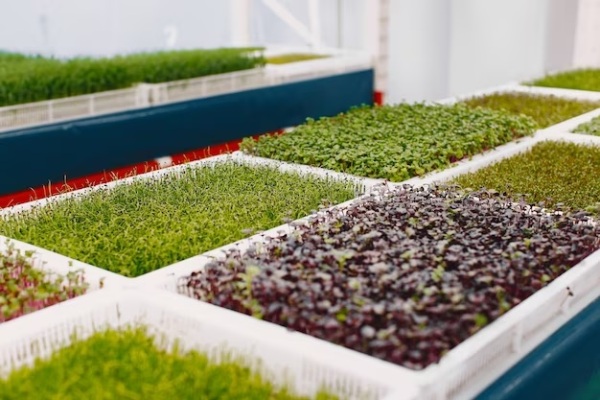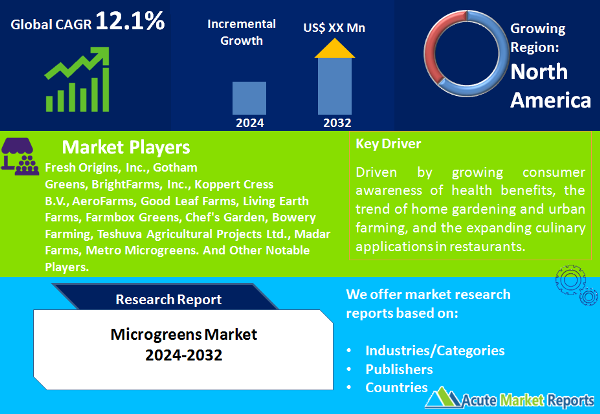
The microgreens market is expected to grow at a CAGR of 12.1% during the forecast period of 2025 to 2033, driven by growing consumer awareness of health benefits, the trend of home gardening and urban farming, and the expanding culinary applications in restaurants. However, challenges in scaling up production pose a notable restraint. Market segmentation reflects the dynamic preferences for farming methods, distribution channels, and regional variations in consumer behavior. Geographically, North America leads in revenue, while the Asia-Pacific region presents high growth potential. Competitive trends highlight the strategies adopted by major players, including Fresh Origins, Gotham Greens, and BrightFarms. These companies leverage sustainability, innovation, and strategic collaborations to maintain a competitive edge. As the microgreens market progresses from 2025 to the forecast period of 2033, addressing scalability challenges, meeting consumer preferences, and adapting to regional nuances will be critical for sustained success in this flourishing market.
Growing Consumer Awareness of Health Benefits
The increasing awareness among consumers regarding the health benefits of microgreens is a significant driver propelling market growth. microgreens, such as kale, broccoli, and radish microgreens, are rich sources of vitamins, minerals, and antioxidants. Studies have highlighted the nutritional superiority of microgreens compared to their mature counterparts, contributing to their appeal among health-conscious consumers. The evidence lies in the rise of culinary and wellness influencers promoting microgreens for their nutritional value through social media platforms. This increased awareness has led to a surge in demand, with consumers incorporating microgreens into their diets to enhance overall health and well-being.
Rising Trend of Home Gardening and Urban Farming
The trend of home gardening and urban farming has become a driving force in the microgreens market. With a growing emphasis on sustainability and the desire for fresh, locally sourced produce, individuals are increasingly cultivating microgreens at home. Indoor vertical farming and home gardening kits provide convenient solutions for individuals to grow their microgreens. The evidence lies in the proliferation of online platforms offering guidance on home microgreen cultivation, coupled with the surge in sales of microgreen seeds and kits. As the trend of home gardening gains momentum, it positively influences the market by fostering a culture of self-sufficiency and promoting the consumption of freshly harvested microgreens.

Expanding Culinary Applications and Restaurant Adoption
The expanding culinary applications of microgreens and their adoption by restaurants contribute significantly to market growth. Chefs worldwide are incorporating microgreens to add visual appeal, texture, and distinct flavors to a variety of dishes. The evidence lies in the menu offerings of upscale restaurants and culinary influencers showcasing the creative use of microgreens in gourmet preparations. As consumer palates become more adventurous and seek diverse gastronomic experiences, the demand for microgreens in restaurants is expected to rise. The market benefits from the endorsement of microgreens by renowned chefs and their integration into mainstream culinary practices.
Challenges in Scaling Up Production
A notable restraint in the microgreens market is the challenge of scaling up production to meet the increasing demand. While home gardening and small-scale farming have gained popularity, fulfilling the requirements of commercial distribution poses challenges. The evidence lies in reports highlighting logistical constraints, limited infrastructure for large-scale microgreens cultivation, and the need for standardized production practices. As demand outpaces the capacity for mass production, there is a risk of supply shortages. Overcoming this restraint requires strategic investments in farming technology, infrastructure, and collaborations to establish efficient and scalable production processes.
Farming Segmentation: Commercial Greenhouse Farming Dominates the Market
In 2024, the microgreens market witnessed the highest revenue from commercial greenhouse farming. However, the highest Compound Annual Growth Rate (CAGR) during the forecast period (2025-2033) is expected from indoor vertical farming. This dynamic growth is driven by the advantages of controlled environments, year-round cultivation, and reduced reliance on external factors. Studies and industry reports support the sustainability and efficiency of indoor vertical farming methods for microgreens. As the market progresses, the shift toward indoor vertical farming is expected to be influenced by factors such as resource efficiency and climate independence.
Distribution Channel Segmentation: Retail Stores Dominate the Market
Retail stores contributed the highest revenue to the microgreens market in 2024, encompassing supermarkets, specialty stores, and farmers' markets. However, the highest CAGR during the forecast period is anticipated from online channels. The evidence lies in the global trend of increasing online grocery shopping and the convenience it offers to consumers. With the ease of access to a wide variety of microgreens through online platforms, coupled with the growing preference for contactless shopping, online distribution channels are poised for significant growth. The market benefits from the convenience and accessibility provided by online platforms, influencing purchasing patterns.
North America Remains the Global Leader
Geographically, North America dominated the microgreens market in 2024, driven by the high demand for fresh and nutritious produce. However, the Asia-Pacific region is expected to exhibit the highest CAGR during the forecast period. The evidence lies in the increasing adoption of Western dietary trends, rising health consciousness, and the influence of culinary diversity in Asia-Pacific countries. These geographic trends emphasize the need for market players to tailor their offerings to regional preferences, culinary traditions, and health and wellness trends.
Market Competition to Intensify during the Forecast Period
In 2024, major players in the microgreens market included Fresh Origins, Inc., Gotham Greens, BrightFarms, Inc., Koppert Cress B.V., AeroFarms, Good Leaf Farms, Living Earth Farms, Farmbox Greens, Chef's Garden, Bowery Farming, Teshuva Agricultural Projects Ltd., Madar Farms, and Metro Microgreens. These companies adopted diverse strategies, including sustainable farming practices, product innovation, and strategic collaborations. The evidence lies in initiatives such as vertical farming technologies, partnerships with restaurants and retailers, and the development of new microgreen varieties. As of 2025, the competitive landscape indicates a market where innovation, sustainability, and strategic alliances are crucial for success. Revenues for 2025 and the expected landscape for the forecast period (2025-2033) reveal a dynamic market where adapting to consumer trends, investing in technological advancements, and addressing scalability challenges are key determinants of success.
Historical & Forecast Period
This study report represents analysis of each segment from 2023 to 2033 considering 2024 as the base year. Compounded Annual Growth Rate (CAGR) for each of the respective segments estimated for the forecast period of 2025 to 2033.
The current report comprises of quantitative market estimations for each micro market for every geographical region and qualitative market analysis such as micro and macro environment analysis, market trends, competitive intelligence, segment analysis, porters five force model, top winning strategies, top investment markets, emerging trends and technological analysis, case studies, strategic conclusions and recommendations and other key market insights.
Research Methodology
The complete research study was conducted in three phases, namely: secondary research, primary research, and expert panel review. key data point that enables the estimation of Microgreens market are as follows:
Market forecast was performed through proprietary software that analyzes various qualitative and quantitative factors. Growth rate and CAGR were estimated through intensive secondary and primary research. Data triangulation across various data points provides accuracy across various analyzed market segments in the report. Application of both top down and bottom-up approach for validation of market estimation assures logical, methodical and mathematical consistency of the quantitative data.
| ATTRIBUTE | DETAILS |
|---|---|
| Research Period | 2023-2033 |
| Base Year | 2024 |
| Forecast Period | 2025-2033 |
| Historical Year | 2023 |
| Unit | USD Million |
| Segmentation | |
|
Microgreens Market Is Projected to Expand At A CAGR Of 12.1% Between 2024 And 2032 | |
Farming Type
| |
Distribution Channel
| |
Produce
| |
|
Region Segment (2023-2033; US$ Million)
|
Key questions answered in this report